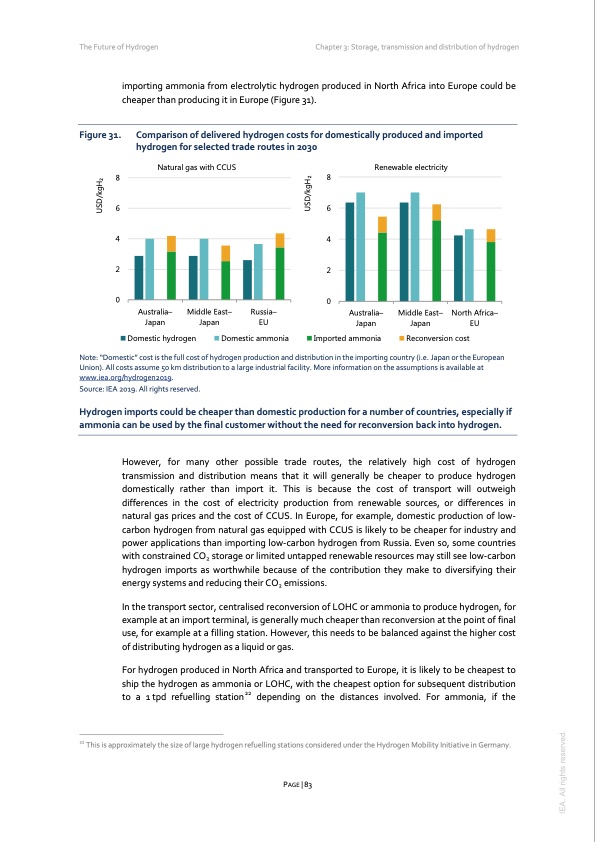
PDF Publication Title:
Text from PDF Page: 083
The Future of Hydrogen Chapter 3: Storage, transmission and distribution of hydrogen importing ammonia from electrolytic hydrogen produced in North Africa into Europe could be cheaper than producing it in Europe (Figure 31). Figure 31. Comparison of delivered hydrogen costs for domestically produced and imported hydrogen for selected trade routes in 2030 Natural gas with CCUS 88 66 44 22 0 Renewable electricity Australia– Japan Middle East– Japan Russia– EU 0 Imported ammonia Middle East– Japan North Africa– EU Domestic hydrogen Domestic ammonia Reconversion cost Note: “Domestic” cost is the full cost of hydrogen production and distribution in the importing country (i.e. Japan or the European Union). All costs assume 50 km distribution to a large industrial facility. More information on the assumptions is available at www.iea.org/hydrogen2019. Source: IEA 2019. All rights reserved. Hydrogen imports could be cheaper than domestic production for a number of countries, especially if ammonia can be used by the final customer without the need for reconversion back into hydrogen. However, for many other possible trade routes, the relatively high cost of hydrogen transmission and distribution means that it will generally be cheaper to produce hydrogen domestically rather than import it. This is because the cost of transport will outweigh differences in the cost of electricity production from renewable sources, or differences in natural gas prices and the cost of CCUS. In Europe, for example, domestic production of low- carbon hydrogen from natural gas equipped with CCUS is likely to be cheaper for industry and power applications than importing low-carbon hydrogen from Russia. Even so, some countries with constrained CO2 storage or limited untapped renewable resources may still see low-carbon hydrogen imports as worthwhile because of the contribution they make to diversifying their energy systems and reducing their CO2 emissions. In the transport sector, centralised reconversion of LOHC or ammonia to produce hydrogen, for example at an import terminal, is generally much cheaper than reconversion at the point of final use, for example at a filling station. However, this needs to be balanced against the higher cost of distributing hydrogen as a liquid or gas. For hydrogen produced in North Africa and transported to Europe, it is likely to be cheapest to ship the hydrogen as ammonia or LOHC, with the cheapest option for subsequent distribution to a 1tpd refuelling station22 depending on the distances involved. For ammonia, if the 22 This is approximately the size of large hydrogen refuelling stations considered under the Hydrogen Mobility Initiative in Germany. Australia– Japan PAGE | 83 IEA. All rights reserved. USD/kgH2 USD/kgH2PDF Image | The Future of Hydrogen 2019

PDF Search Title:
The Future of Hydrogen 2019Original File Name Searched:
the_future_of_hydrogen.pdfDIY PDF Search: Google It | Yahoo | Bing
NFT (Non Fungible Token): Buy our tech, design, development or system NFT and become part of our tech NFT network... More Info
IT XR Project Redstone NFT Available for Sale: NFT for high tech turbine design with one part 3D printed counter-rotating energy turbine. Be part of the future with this NFT. Can be bought and sold but only one design NFT exists. Royalties go to the developer (Infinity) to keep enhancing design and applications... More Info
Infinity Turbine IT XR Project Redstone Design: NFT for sale... NFT for high tech turbine design with one part 3D printed counter-rotating energy turbine. Includes all rights to this turbine design, including license for Fluid Handling Block I and II for the turbine assembly and housing. The NFT includes the blueprints (cad/cam), revenue streams, and all future development of the IT XR Project Redstone... More Info
Infinity Turbine ROT Radial Outflow Turbine 24 Design and Worldwide Rights: NFT for sale... NFT for the ROT 24 energy turbine. Be part of the future with this NFT. This design can be bought and sold but only one design NFT exists. You may manufacture the unit, or get the revenues from its sale from Infinity Turbine. Royalties go to the developer (Infinity) to keep enhancing design and applications... More Info
Infinity Supercritical CO2 10 Liter Extractor Design and Worldwide Rights: The Infinity Supercritical 10L CO2 extractor is for botanical oil extraction, which is rich in terpenes and can produce shelf ready full spectrum oil. With over 5 years of development, this industry leader mature extractor machine has been sold since 2015 and is part of many profitable businesses. The process can also be used for electrowinning, e-waste recycling, and lithium battery recycling, gold mining electronic wastes, precious metals. CO2 can also be used in a reverse fuel cell with nafion to make a gas-to-liquids fuel, such as methanol, ethanol and butanol or ethylene. Supercritical CO2 has also been used for treating nafion to make it more effective catalyst. This NFT is for the purchase of worldwide rights which includes the design. More Info
NFT (Non Fungible Token): Buy our tech, design, development or system NFT and become part of our tech NFT network... More Info
Infinity Turbine Products: Special for this month, any plans are $10,000 for complete Cad/Cam blueprints. License is for one build. Try before you buy a production license. May pay by Bitcoin or other Crypto. Products Page... More Info
| CONTACT TEL: 608-238-6001 Email: greg@infinityturbine.com | RSS | AMP |